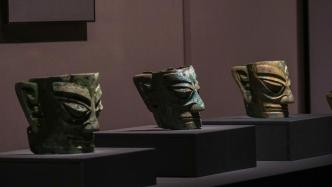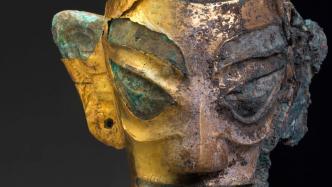
The "Starry China - Sanxingdui Jinsha Ancient Shu Civilization Exhibition" is currently on display at the East Hall of the Shanghai Museum. The "Gold Mask and Hairpin Bronze Human Head" at the entrance of the exhibition hall, which is unveiled for the first time, is shining with golden light, which is particularly majestic and mysterious. Visitors may not know that the extraordinary bronze human head in the exhibition hall had a completely different appearance when it was unearthed: its neck was broken, the lower end was incomplete, the surface was covered with a lot of ivory, and the gold mask was squeezed and deformed... It was the Shanghai Museum's cultural relics restoration team who used their superb skills to restore it to its former glory.
Recently, The Paper interviewed Zhang Peichen, inheritor of the national intangible cultural heritage project "Bronze Restoration and Reproduction Techniques" and research curator of the Artifact Restoration Research Laboratory of the Cultural Relics Protection and Technology Center of the Shanghai Museum, and asked him to tell the story behind the protection and restoration of the bronze cultural relics unearthed from Sanxingdui.
"I went to Sichuan to participate in the protection and restoration project of Sanxingdui unearthed cultural relics and lived in Sanxingdui for several months. Sometimes after a busy day, I walked out of the museum and saw the sunset by the Yazi River. The ancient Sanxingdui people should have seen the same scene, and I had a strong sense of traveling through time and space." Zhang Peichen said.
The Paper: When did you start to get involved in the restoration of cultural relics unearthed from the Sanxingdui site in Sichuan?
Zhang Peichen: At the beginning of 2023, the Shanghai Museum signed a cooperation framework agreement with a number of cultural and museum institutions, including the Sichuan Provincial Institute of Cultural Relics and Archaeology, the Chengdu Institute of Cultural Relics and Archaeology, the Jinsha Site Museum, and the Sanxingdui Museum, opening up comprehensive cooperation between Shanghai and Sichuan in the field of cultural relics. Against this background, the Shanghai Museum and the Sichuan Provincial Institute of Cultural Relics and Archaeology jointly carried out the "Sanxingdui Excavated Bronze Cultural Relics Protection and Restoration Project" from March 2023 to January 2024, focusing on the cleaning, restoration, and testing of the latest unearthed cultural relics discovered in Sanxingdui's No. 7 and No. 8 pits, promoting comprehensive exchanges between the two sides in cultural relic protection and restoration technology, scientific research, and talents.

New archaeological discovery site at Sanxingdui ruins
The "Bronze Restoration and Reproduction Skills" team of the Shanghai Museum consists of 5 people. This time, our team was divided into 2 groups. In nearly a year, we traveled alternately between Shanghai and Guanghan, Sichuan, and completed the cleaning and restoration of nearly 100 pieces (groups) of bronze cultural relics unearthed from Sanxingdui. Among them, nearly 50 pieces (groups) of bronze cultural relics were transported to Shanghai for restoration. During the cleaning process, we cleaned out more than 20 cultural relics such as gold ornaments, bronze kneeling figures, bronze dragons, bronze spears, bronze snake back feathers, bronze branches, bronze bird wings, bronze flower buds, and copper plates from 10 large bronze containers and bronze heads; more than 150 pieces of fish-shaped, leaf-shaped, round, scepter-shaped, and curled copper foils; more than 10 ivory small animals, ivory handle-shaped objects, and ivory tube beads, as well as a large number of seashells and mother-of-pearl products. Among them, bronze dragons, ivory small animals and other types of objects were found for the first time in Sanxingdui unearthed cultural relics.
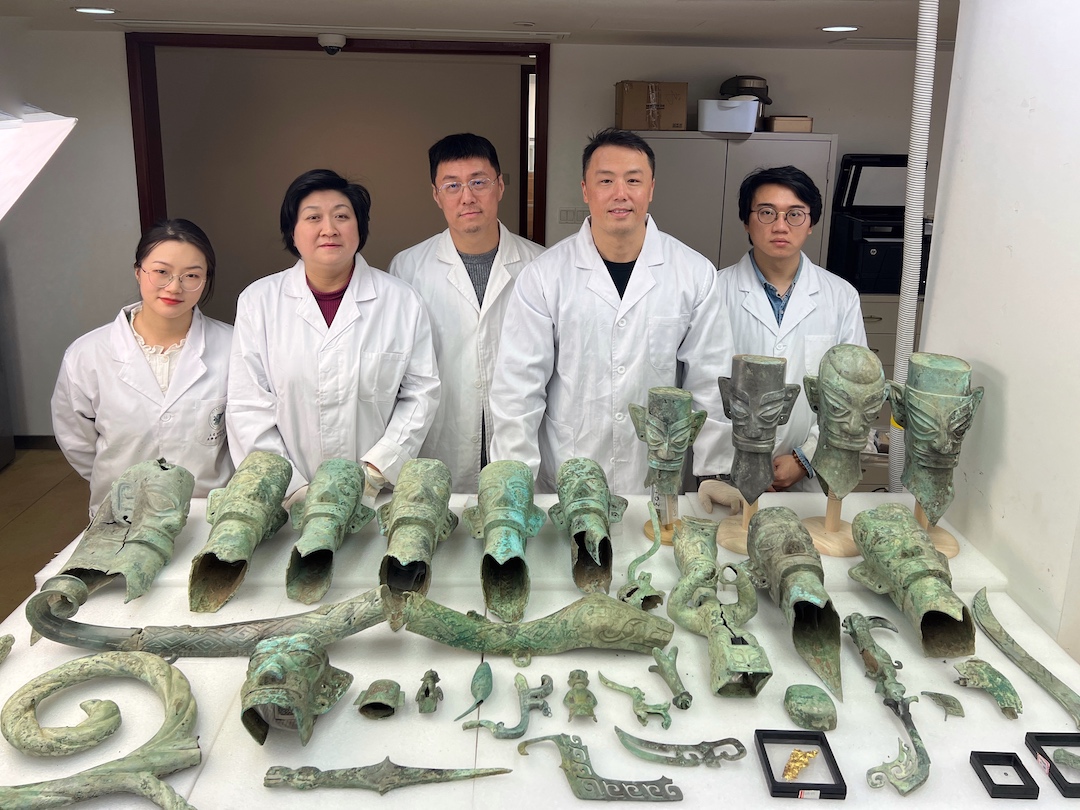
Members of the Shanghai Museum's "Bronze Restoration and Reproduction Skills" team and some of the bronze artifacts unearthed from Sanxingdui that they have cleaned and restored. (Photo provided by the interviewer, same below)
The Paper: I heard that before the Shanghai Museum, the cultural relics unearthed from Sanxingdui had never been transported out of the province in large quantities for cleaning and restoration.
Zhang Peichen: Yes, the Shanghai Museum is strong in cultural relic protection technology and cultural relic restoration. The Cultural Relic Protection Technology Center has a variety of scientific and technological testing equipment and technologies such as large-scale CT scanning and "thermoluminescence" detection. With the help of these advanced scientific instruments, we can reveal the hidden information in the cultural relics and provide strong support for humanities research. For example, what is the composition of the surface attachments of the unearthed cultural relics in the Sanxingdui site? What is the casting process of the unearthed bronzes? This information is very helpful for the archaeological and historical research of Sanxingdui.
The Paper: Was the cooperation with the relevant cultural and museum institutions in Sichuan on the protection and restoration of bronze cultural relics smooth? How is it different from the restoration of cultural relics in Shanghai?
Zhang Peichen: Although the Shanghai Museum is well-known for its "bronze restoration and reproduction skills", we have previously cooperated with cultural and museum units in Shaanxi, Shanxi and other provinces on the restoration and protection of cultural relics. However, this is our first contact with the Sichuan cultural relic restoration team. Both sides have a period of running-in on working methods, processes and restoration techniques.
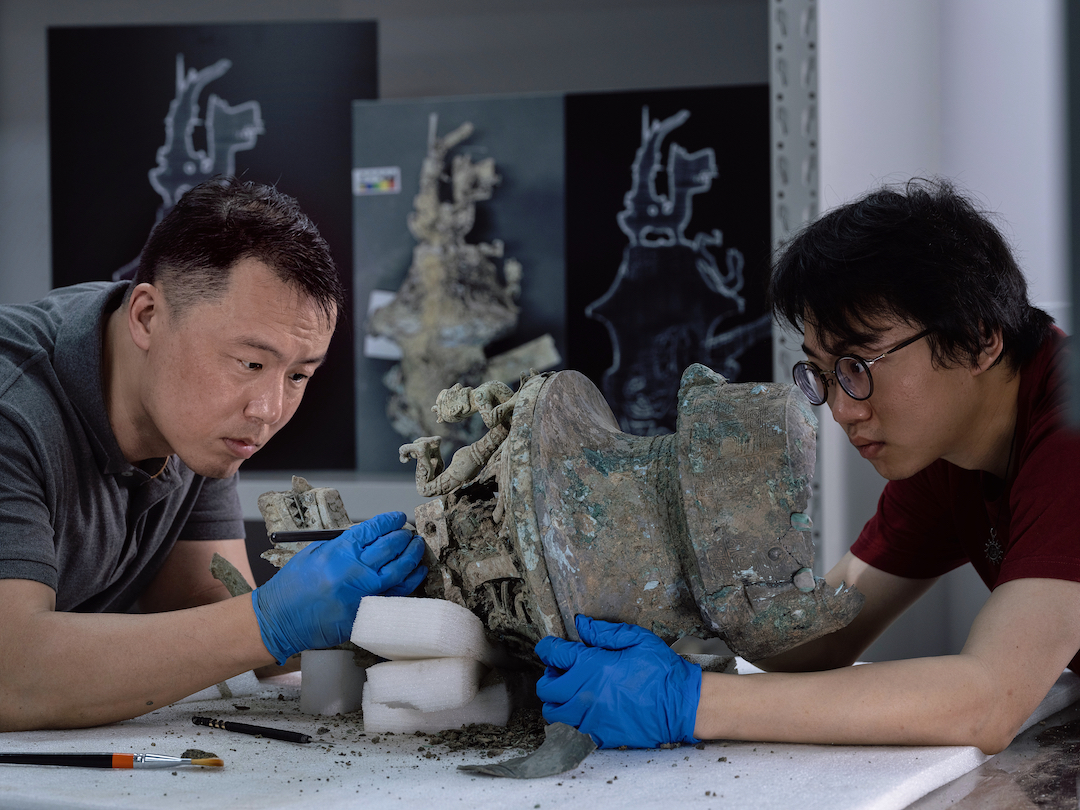
Shanghai Museum cultural relics restoration staff cleaned the lid and remains of the mythical beast unearthed from Sanxingdui Pit No. 8
Through work exchanges, it was discovered that the bronze restoration skills of Sanxingdui can be traced back to the Shanghai Museum. In 1976, the State Administration of Cultural Heritage commissioned the Shanghai Museum to hold a national bronze restoration training course. The training lasted for half a year, and the course was well-designed and reasonable. From basic restoration methods such as rust removal, welding and matching of bronzes to the process of drawing, engraving, mold turning, casting and other processes of bronze decorations, it almost covered the main basic skills of bronze restoration and reproduction. Teacher Yang Xiaowu from the Sanxingdui Museum was fortunate to be the only student selected by Sichuan. At that time, he was taught by many teachers including Wang Rongda, Gu Youchu, Huang Rensheng, and other old experts in bronze restoration at the Shanghai Museum. Through the training of the professional capabilities of the teachers from the Shanghai Museum, a solid foundation was laid for Teacher Yang's subsequent career in the restoration of Sanxingdui cultural relics. It is also a kind of dissemination and inheritance of the Shanghai Museum's "bronze restoration and reproduction skills."
The Paper: Please tell us about the restoration process of the star exhibit of this exhibition, the bronze human head with a golden mask.
Zhang Peichen: The "Bronze Human Head with Gold Mask and Hairpin" was unearthed from the No. 8 sacrificial pit at the Sanxingdui site. More than 70 bronze heads were unearthed from the entire No. 8 pit, but this is the only case where a gold mask is completely attached to a bronze head. Among the cultural relics unearthed from Sanxingdui, objects made of gold are of higher grade than other bronze objects. This is also the only bronze head with a gold mask still attached in the six sacrificial pits discovered in the new round of Sanxingdui in 2021, which is enough to show the precious value of this cultural relic.
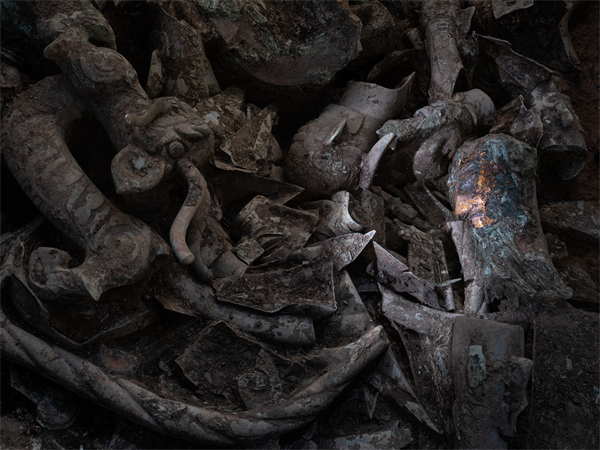
The bronze human head with a golden mask and hairpin when it was first discovered in Pit 8
Due to the complicated overlapping of cultural relics in Pit 8, the bronze cultural relics at the bottom were squeezed by the ash and ivory layers above and corroded by the surrounding burial environment, and the deformation and breakage were serious. When this bronze head was first discovered, it was covered and wrapped by various attachments. Under the light of archaeological excavation, the gleaming gold mask showed its uniqueness. After preliminary cleaning of the surrounding environment, the head of a person wearing a gold mask was first seen. It was lying on its side in a corner of Pit 8. There were a lot of through cracks on the neck of the bronze head. At this time, cleaning must be done very carefully, and any slight movement will cause further fractures. The cultural relics protection staff used a medical plaster bandage to fix the neck and then extracted it as a whole, and transported it to the Cultural Relics Protection Center for later protection and restoration.
Compared with the previous archaeological site extraction work, the later cleaning and restoration work is more difficult. The entire head is wrapped in thick ivory fragments and soil inside and outside, and the two sides of the gold mask are squeezed and severely twisted. Bronze oxide has invaded the loose ivory, causing the ivory fragments and bronze oxides attached to the gold mask and bronze head to mix together and become extremely hard. During the cleaning process, it was discovered that the eyes and ears of the gold mask were painted in black and red. Painted and lacquered patterns are a rare and special type of decorative patterns on bronze ware, which is a combination of metal, pigment and natural organic binder. Similarly, due to the aging of organic binders, the painted decorations on bronze cultural relics have become extremely fragile and precious. The biggest difficulty in the cleaning work is to clean and separate the hard attachments attached to the gold while preserving the painted decorations.
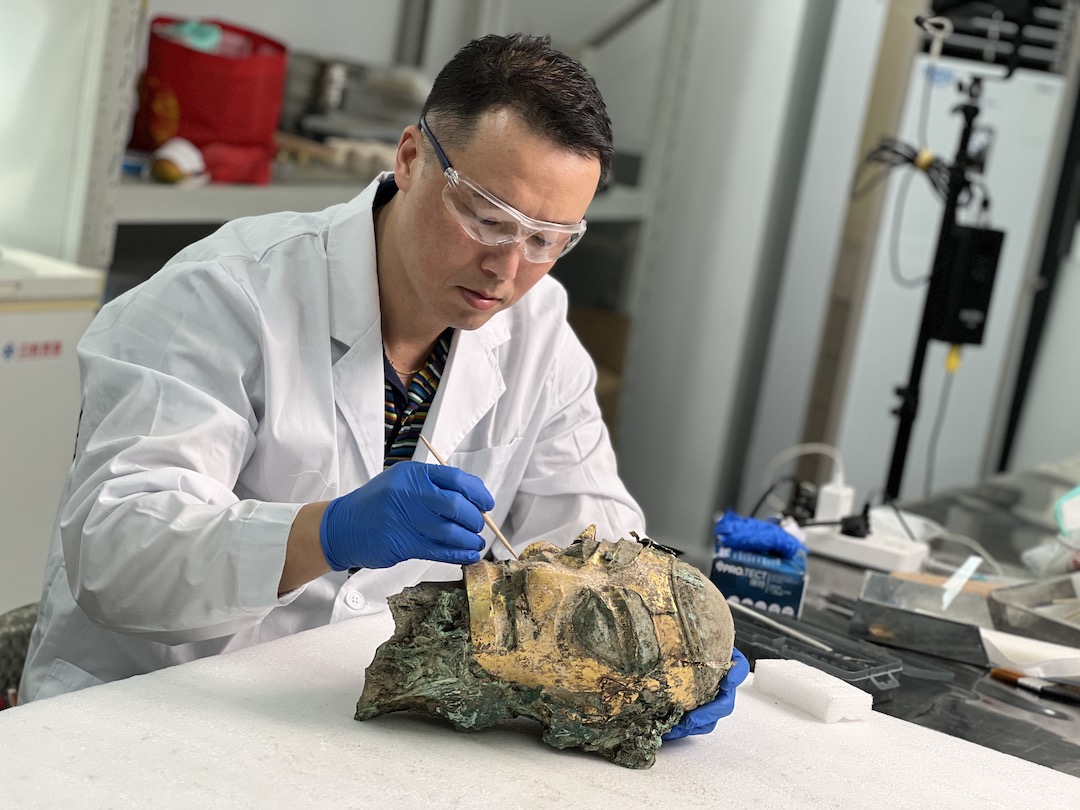
Zhang Peichen, inheritor of the Shanghai Museum's bronze restoration and reproduction skills, cleans and reshapes the bronze head of a man with a golden mask and hairpin
The shaping of the gold mask is also a major difficulty in the restoration process. The ears and strip crowns on both sides of the gold mask are severely deformed, and the ears are folded and squeezed to one-eighth of the original area. Gold has good ductility, but the gold products found in the Sanxingdui site, including the mask, are not 100% pure gold. They contain a part of silver. Although the hardness has been improved, it is easy to break during the shaping process. With decades of experience in cultural relics restoration, a method of mixing tools of different hardness was used to successfully clean up the attachments, and the deformed ears were completely unfolded and reset, and the painted ears were also preserved.
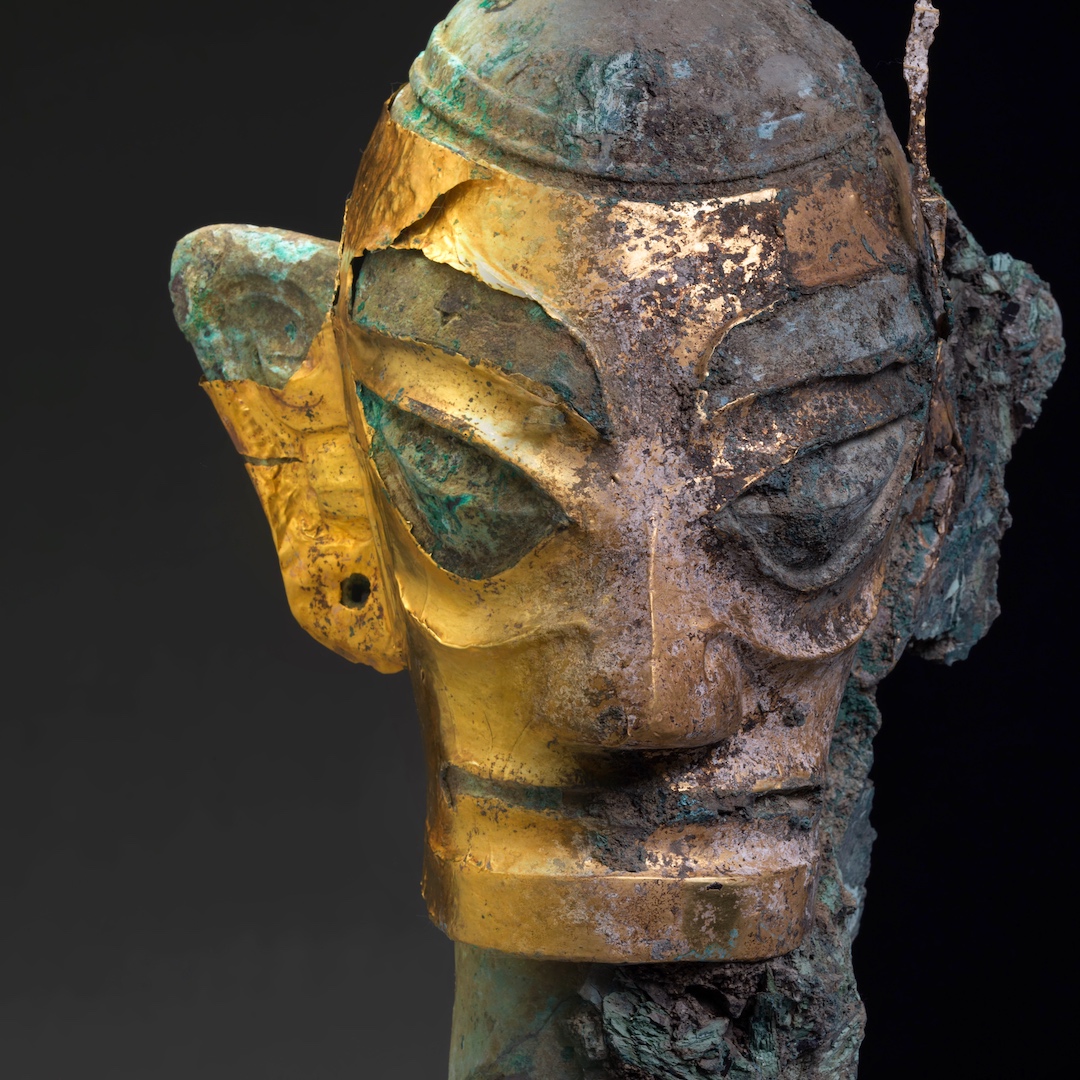
Comparison of the bronze human head with a golden mask and hairpin before and after cleaning and restoration
The head after cleaning is dome-shaped, and the hair seems to be combed from the back to the front, with the ends of the hair gathered inside the mask, and the hairline is clearly visible. The eyebrows, eyes, and mouth of the gold mask are hollowed out. There are triangular decorations above the ears on both sides of the forehead, which are connected to the triangular decorations above the ears. The eyebrows are sharp, and the ends of the eyebrows are straight. The nose bridge is high, and the two nostrils are in an "M" shape. The wide mouth is slightly open, and the corners of the mouth are hooked down. The earlobes of both ears are pierced. It is worth mentioning that the small square hole behind the head of this head was found during the cleaning process. Many people may think that this is damaged, but it is not. Compared with other Sanxingdui heads, this hole is exactly the connection point between the back of the head and the hairpin. At that time, the ancient Sanxingdui people connected the hairpin with the head through this secondary casting process, which reflects the superb casting skills and wisdom of the ancient Sanxingdui people. This is also the reason why this head is officially named "Gold Mask Hairpin Bronze Head". With the continuous progress of the Sanxingdui archaeological excavation, we look forward to finding his lost hairpin in new excavations in the near future. We also hope to personally help him separate and put back his hairpin and show his heroic spirit again.
The Paper: During the cleaning and restoration process, what kind of restoration concept did you adhere to in participating in this important work?
Zhang Peichen: During the cleaning and restoration process of the Sanxingdui cultural relics, we tried our best not to disturb the original state of the cultural relics and retain the greatest original information of the cultural relics. Cultural relic restorers can be said to be the people who have the deepest knowledge of the information of damaged cultural relics, because through each restoration, they can understand the internal structure, casting process, corrosion composition, packaging information, etc. of the cultural relics. Many times, when the broken cultural relics are restored and presented to the audience, many production traces and information have been hidden inside and cannot be observed from the outside.

A bronze human head that was severely squeezed and deformed when it was unearthed
Visitors to this exhibition will find a severely squeezed and deformed bronze human head in our exhibition hall. When it was unearthed, its cheeks and neck were squeezed and deformed, and the head was filled with a lot of soil. When it was transported to the Shanghai Museum for cleaning, we found through CT scanning that there was a hemispherical bronze eye blister inside its head, but due to the squeezing and deformation of the neck, the eye blister could not be removed and is still inside. The reason why we did not correct it is that the deformation and broken diseases of many artifacts in the Sanxingdui sacrificial pit were not caused by the burial environment. Many phenomena indicate that they were most likely smashed and thrown into the pit at the time. This behavior may contain a certain meaning of sacrifice or custom at the time. We believe that such an original state should be preserved. If it is forcibly restored, it will interfere with its original information. Now it is also displayed in the original state in the exhibition hall. We think this state is quite good, telling the audience that the original state is like this.
The Paper: What have you learned from this restoration experience?
Zhang Peichen: From the perspective of a restorer, as a cultural relic restorer, it is a great honor to be able to participate in the cultural relic protection and restoration work of a national-level archaeological excavation project like Sanxingdui. This is a coincidence of good timing, location and people. Each of us participants is very serious about this project, and we will give full play to the advantages and strengths of the Shanghai Museum in bronze restoration and promote the exchange of bronze restoration skills in cooperation.
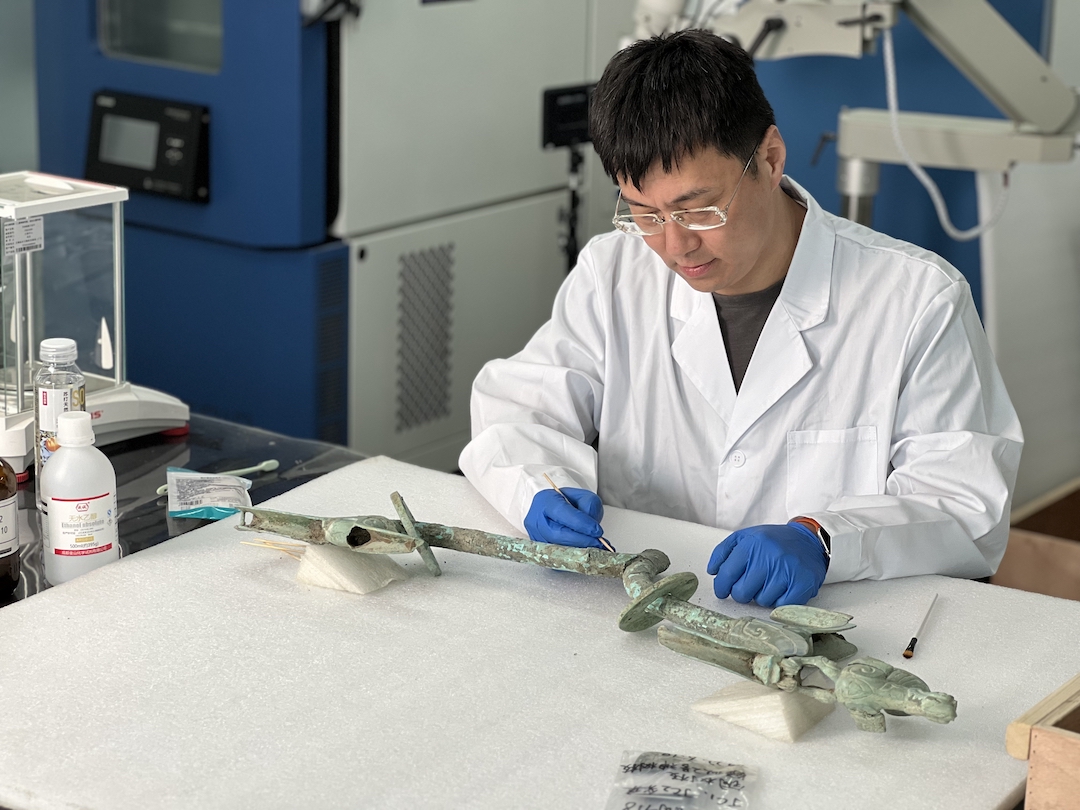
Shanghai Museum cultural relics restorers clean up bronze cultural relics unearthed from Sanxingdui
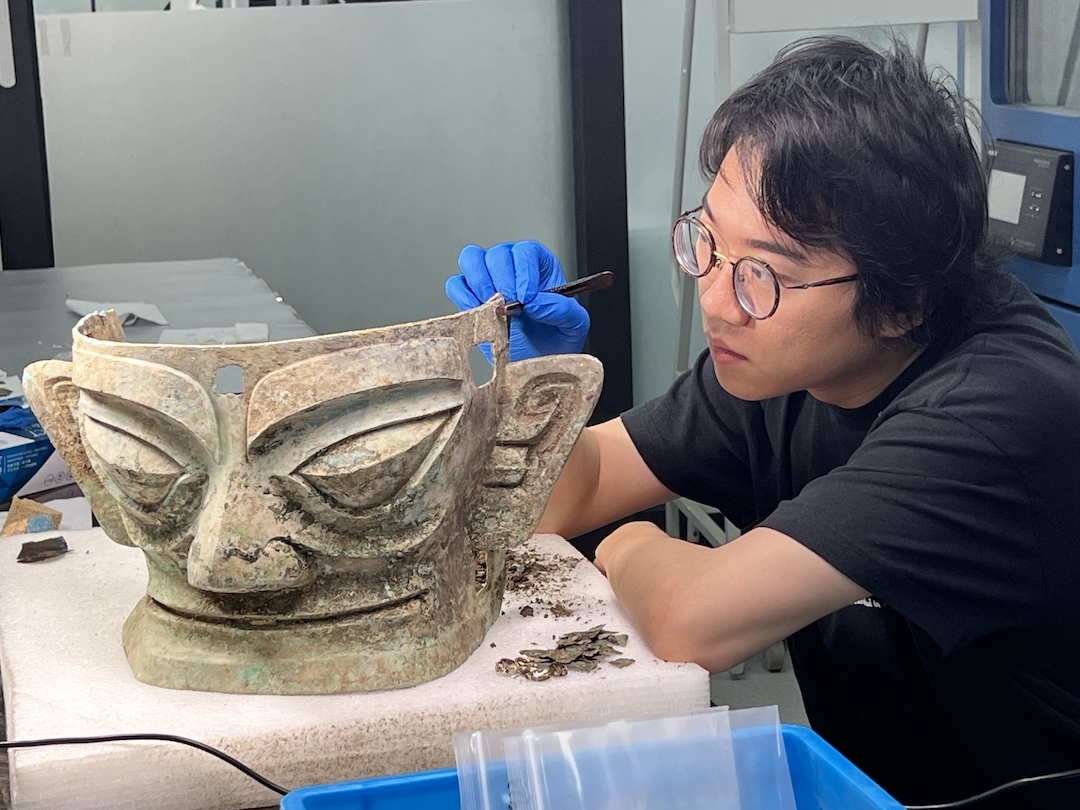
Shanghai Museum cultural relics restorers clean up bronze cultural relics unearthed from Sanxingdui
The Paper: Going to the site where cultural relics were unearthed and carrying out restoration must be a unique experience in your career, right?
Zhang Peichen: The experience of seeing the same cultural relic in a museum and at the site of its excavation is completely different. I have lived in Sanxingdui for several months this time. The area where we work is the original site of the Sanxingdui civilization 3,000 years ago, and the Yazi River still flows by the side 3,000 years ago. Sometimes I am busy all day, and when I walk out of the museum, I see the sunset by the Yazi River. The ancient Sanxingdui people should have seen the same scene. I have a strong sense of time travel, and 3,000 years is just a fleeting moment.

Sanxingdui in the sunset
The Sanxingdui cultural relics in these archaeological excavations seem to be frozen in time. From the moment they were thrown down to the moment they were discovered by people, they have remained there without changing. It feels very wonderful.
